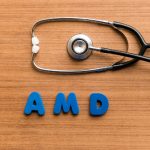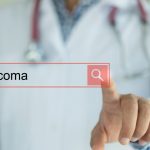Macular Degeneration Treatments
Medically Reviewed by: Dr. David Evans

Although there are no treatments available in the U.S. that can completely restore vision loss caused by macular degeneration, there are a number of treatments that can provide some degree of improvement and/or help slow the progression. Your specific course of treatment will depend on which variation of age-related macular degeneration (AMD) you suffer from — dry AMD (non-neovascular) or wet AMD (neovascular).
More than 80 percent of all AMD cases are of the dry variety. Although dry AMD can often be managed with certain lifestyle changes, there is no specific treatment for this advancing disease. Only wet AMD can be treated. But keep in mind the treatment does not constitute a cure.
Dry AMD Treatments
The dry variant of age-related macular degeneration represents an earlier stage of the disease, during which vision loss tends to be slower (though dry AMD can progress to the more serious wet variant). Dry AMD treatments therefore focus on slowing the transition to wet AMD and the increased likelihood of vision loss. The primary treatment for dry AMD is nutritional therapy.
According to the American Academy of Ophthalmology (AAO), a combination of antioxidant vitamins and zinc can help slow the progression of dry AMD in people at high risk of developing wet AMD. Targeted nutritional therapy can help support the cells of the macula, helping to minimize deterioration.
Nutritional supplements found to be beneficial in treating dry AMD include:
- Vitamin C
- Vitamin E
- Lutein
- Zeaxanthin
- Zinc Oxide
- Copper (cupric oxide)
Although these supplements have shown to be helpful as a treatment for those with high levels of drusen (a type of lipid deposit beneath the retina) or those otherwise at greater risk of developing the more serious wet form of macular degeneration, they may not be as effective in providing relief for those with minimal macular degeneration or those in the earliest stages of dry AMD.
Other studies cited by the AAO found benefits for female dry AMD patients taking folic acid, vitamin B6 and vitamin B12. Furthermore, the AAO noted the preventative benefits of diets rich in dark, leafy greens and bright, colorful fruits and vegetables.
Basically, the treatment goal with regard to dry macular degeneration is to create the proper eye nutrition to slow or stop the progression of the disease.
Wet AMD Treatments
Once macular degeneration has progressed to wet AMD, you are at greater risk of vision loss. Although only 10-15 percent of all cases of macular degeneration are classified as wet, they represent 90 percent of all AMD-related vision loss.
Generally speaking there are three options for treating wet macular degeneration: anti-VEGF, thermal laser or photodynamic therapy (PDT).
Anti-VEGF Treatment: This is a drug treatment that targets the chemical in your body that is responsible for the abnormal growth of blood vessels in the eye attributable to AMD: vascular endothelial growth factor (VEGF). Avastin, Lucentis, Macugen and Eylea are four commonly used anti-VEGF drugs. During treatment, your ophthalmologist injects the drug into the back of your eye where it inhibits the abnormal growth of blood vessels and stems associated leaks. Blocking the growth of new vessels and slowing the leakage can slow the progression of the disease and blunt vision loss. Multiple anti-VEGF treatments will likely be required over several months in order to get the maximum effect. Your eye doctor may suggest anti-VEGF treatment in conjunction with other therapies (such as PDT) to best attack the progression of AMD.
Thermal Laser Treatment: Although no longer used as frequently as anti-VEGF drug treatment, thermal laser treatment can (in theory) be effective in slowing the progression of macular degeneration. Also called laser photocoagulation, this treatment targets and destroys abnormal blood vessel growth, and/or seals off associated leaks. Essentially, the laser is used to cauterize the wayward blood vessels. Unfortunately, laser treatment can literally leave its mark in the form of retinal scarring. Blood vessels that are in very close proximity to the central part of your vision are typically not treated with a laser because of the possibility of scarring healthy retinal tissue and creating blind spots in this critical area of the visual system. As a result, thermal laser treatment is not widely used as a treatment for wet AMD. However, researchers are working diligently to develop new methods to reduce scarring. Similarly, researchers are working on ways in which to apply laser treatment for dry AMD.
Photodynamic Therapy: PDT treatment is something of a combination between drug and laser treatment. Patients are given a light-activated drug (photosensitizer) called Visudyne by injecting it in the arm. As the drug passes through the retinal blood vessels, the Visudyne is activated using a low-energy laser, creating a chemical reaction that destroys abnormal blood vessels. Candidacy for PDT is limited to 40-60 percent of AMD cases because of the specific nature of the treatment. Patients must present with a specific blood vessel growth pattern in order to qualify. PDT is sometimes used in conjunction with anti-VEGF drugs to more effectively target the abnormal blood vessel growth.
Learn More about Macular Degeneration Treatments
There may not be a cure for macular degeneration, but if your condition is diagnosed early enough there are a number of steps that can be taken to help manage disease progression. Check out our introduction to age-related macular degeneration to learn more about what causes the common eye condition and the associated risk factors. If you or a loved one has AMD or is at risk of developing it, schedule a consultation with an ophthalmologist to get a comprehensive eye exam and discuss your treatment options.




